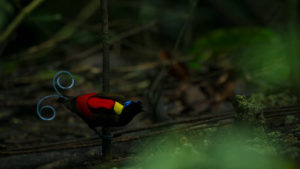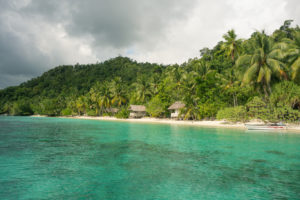Most divers know of Raja Ampat, one of the world’s best scuba-diving destinations. This Indonesian archipelago is also known as the Four Kings. Justifiably, it attracts scuba enthusiasts from around the world who dream of a colorful and abundant underwater wonderland. Raja Ampat’s spectacular marine world gets a lot of attention from journalists, photographers, and scuba fans, but Raja offers equally stunning topside attractions. If you’re planning a land-based trip here for your next scuba adventure, stay near Waigeo to enjoy some of these unique topside attractions.
Pianemo

You may have seen iconic photos of a cluster of island mounds floating in an ocean of turquoise. Photos of Pianemo represent Raja Ampat in almost every media outlet, travel magazine, and marketing tool. And understandably so, as the view from the top of Pianemo leaves most people speechless.
If you’re staying in any of the islands around Waigeo, you can hire a speedboat to take you to Pianemo. From the main town of Waisai in Waigeo, the trip can take about 1.5 hours one way. Even though Pianemo has become a bit touristy, the view makes the trip worthwhile.
Arborek village

As part of the Indonesia government’s tourist program, the tiny island of Arborek and its native Papuan habitants offer performances with traditional dance and music to introduce visitors to a unique cultural experience. The white-sand beaches surrounding the island, the local village life, and stunning reefs just offshore make this enchanting island a must-visit if you are staying in Waigeo. Arborek village also offers simple accommodations, souvenir shops, small stands for snacks and drinks and even a dive center. Conveniently located en route to the famous Pianemo, Arborek makes for a great stopover.
Bird watching

Raja Ampat is home to endemic Birds of Paradise (Cendarawasih) which, according to National Geographic, are “some of the world’s most dramatic and attractive birds.” Aside from the colorful and vibrant colors, the Cendarawasih birds are also renowned for being fabulous dancers and singers. Of the 41 Cenderawasih species in Indonesia, 37 live in the Papua region alone. Two of these species in particular — Wilson’s Bird of Paradise and Paradise Red — are endemic to Raja Ampat. They most commonly live in the jungles of Batanta and Waigeo.
Since these rare birds appear mostly in the early mornings from around 5:30 to 6:30 am, you can even squeeze in a birdwatching tour before you dive. Many local guides will be happy to show you around.
Jungle exploration

Much of Raja remains relatively untouched and unexplored rainforest, abundant with fascinating wildlife and plant species. In the thick jungle of Waigeo, you can find Kalibiru, the highlight of my last trip to Raja Ampat. This crystal-clear, turquoise freshwater river runs through the lush, green forest. Even more spectacularly, you can watch this river originating from the ground, gushing out between the rocks and dirt at your feet.
Island hopping

Aside from the four main islands that make up Raja Ampat, smaller islands are also dot the region. Most have beautiful lagoons, white-sand beaches, and shallow reefs. Often, you can simply jump in with your mask and snorkel and encounter reef sharks, turtles, and even dugongs if you’re lucky.
Hire a speedboat for the day and explore some of the remote, uninhabited islands, with some of the planet’s most stunning shades of blue. No matter how you choose to spend your topside time in Raja Ampat, it will not disappoint you.
Mo is a Bali-based scuba instructor whose current passions include coconut ice cream, rescuing street dogs, and sharing her travel tips and resources on Travelust 101. You can follow her adventures on Instagram and contact her for tips on guides for Kalibiru.





